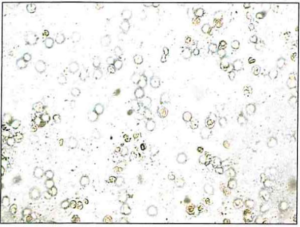Clinical Microscopy Test 5
Quiz Summary
0 of 20 Questions completed
Questions:
Information
You have already completed the quiz before. Hence you can not start it again.
Quiz is loading…
You must sign in or sign up to start the quiz.
You must first complete the following:
Results
Results
0 of 20 Questions answered correctly
Your time:
Time has elapsed
You have reached 0 of 0 point(s), (0)
Earned Point(s): 0 of 0, (0)
0 Essay(s) Pending (Possible Point(s): 0)
Categories
- Not categorized 0%
- 1
- 2
- 3
- 4
- 5
- 6
- 7
- 8
- 9
- 10
- 11
- 12
- 13
- 14
- 15
- 16
- 17
- 18
- 19
- 20
- Current
- Review
- Answered
- Correct
- Incorrect
-
Question 1 of 20
1. Question
The centrifuged sediment for a random urine sample collected from a 17-year-old female patient is shown in the photomicrograph.

The reagent test strip is negative for leukocyte esterase and nitrite. The elements seen in the sediment are most likely the result of:
CorrectIncorrect -
Question 2 of 20
2. Question
Oval fat bodies are:
CorrectIncorrect -
Question 3 of 20
3. Question
Microscopic examination of a urine sediment reveals the presence of ghost cells which would most likely be associated with a:
CorrectIncorrect -
Question 4 of 20
4. Question
Glitter cells are a microscopic finding of:
CorrectIncorrect -
Question 5 of 20
5. Question
Which of the following cells is most commonly associated with a non-clean-catch specimen and/or vaginal contamination?
CorrectIncorrect -
Question 6 of 20
6. Question
Identify the elements indicated by the arrows in the photomicrograph:
 CorrectIncorrect
CorrectIncorrect -
Question 7 of 20
7. Question
Identify the type of cast seen in the photomicrograph:
 CorrectIncorrect
CorrectIncorrect -
Question 8 of 20
8. Question
The presence of which of the following is associated with bacterial vaginosis?
CorrectIncorrect -
Question 9 of 20
9. Question
Which of the following elements is most likely to be seen in a urine sediment as a result of catheterization?
CorrectIncorrect -
Question 10 of 20
10. Question
What is the most likely diagnosis given this microscopic finding?
 CorrectIncorrect
CorrectIncorrect -
Question 11 of 20
11. Question
Identify the elements seen in the photomicrograph:
 CorrectIncorrect
CorrectIncorrect -
Question 12 of 20
12. Question
Urinary casts are primarily composed of:
CorrectIncorrect -
Question 13 of 20
13. Question
Examination for casts should be performed:
CorrectIncorrect -
Question 14 of 20
14. Question
Which of the following casts is most likely to be found in a urine sample from an apparently healthy person?
CorrectIncorrect -
Question 15 of 20
15. Question
Which of the following casts is most indicative of renal failure/end stage renal disease?
CorrectIncorrect -
Question 16 of 20
16. Question
Shortly after collection of a random urine sample, the laboratorian performed a microscopic urinalysis and reported the results shown in the table:
test
result
WBC
10-13/HPF
RBC
2-6/HPF
hyaline casts
5-7/LPF
bacteria
1+
The urine sediment is reevaluated by a trainee 2 hours later and similar values were reported for the WBC, RBC, and bacteria, but they found no hyaline casts. The most probable explanation for this discrepancy is that the casts dissolved due to a(n):
CorrectIncorrect -
Question 17 of 20
17. Question
Which of the following aids in differentiating a spherical transitional cell from a round renal tubular cell?
CorrectIncorrect -
Question 18 of 20
18. Question
The presence of which of the following urine microscopic constituents would best differentiate between cystitis and pyelonephritis?
CorrectIncorrect -
Question 19 of 20
19. Question
Renal tubular epithelial cell casts are most indicative of:
CorrectIncorrect -
Question 20 of 20
20. Question
Hyaline casts found in the urine of a football player admitted to the hospital following a concussion are most likely the result of:
CorrectIncorrect